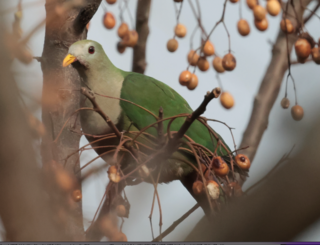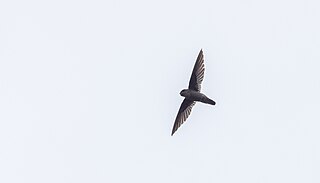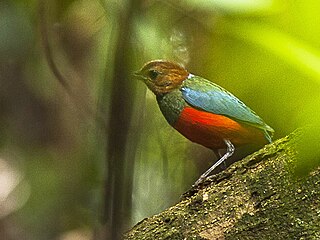
The black-chinned fruit dove, also known as the black-throated fruit dove or Leclancher's dove. It is found in the lowland forests of the Philippines and Taiwan.

The uniform swiftlet, also known as the Vanikoro swiftlet or lowland swiftlet, is a gregarious, medium-sized swiftlet with a shallowly forked tail. The colouring is dark grey-brown, darker on the upperparts with somewhat paler underparts, especially on chin and throat. This species is widespread from the Philippines through Wallacea, New Guinea and Melanesia. It forages for flying insects primarily in lowland forests and open areas. It nests in caves where it uses its sense of echolocation, rare in birds, to navigate.

The Philippine megapode, also known as the Philippine scrubfowl or the Tabon scrubfowl, is a species of bird in the family Megapodiidae. It is found in the Philippines, northeastern Borneo, and Sulawesi. It has a wide range of natural habitats which include tropical dry forest, tropical moist lowland forest, tropical moist montane forest and small islands. The species was named after the collector Hugh Cuming.

The Philippine tailorbird, also known as the Visayan tailorbird or the Chestnut-crowned tailorbird is a species of bird formerly placed in the "Old World warbler" assemblage, but now placed in the family Cisticolidae. It is native to the Philippines in Western Visayas. Its natural habitats are tropical moist lowland forests, tropical mangrove forests and secondary growth.

The gray-backed tailorbird is a species of bird formerly placed in the "Old World warbler" assemblage, it but now placed in the family Cisticolidae. It is endemic to the Philippines found only on the islands of Luzon and Catanduanes.

The edible-nest swiftlet, also known as the white-nest swiftlet, is a small bird of the swift family which is found in Southeast Asia. Its opaque and whitish bird nest is made exclusively of solidified saliva and is the main ingredient of bird's nest soup, a delicacy of Chinese cuisine. Germain's swiftlet is now treated as conspecific with this species.

The Philippine swiftlet is a species of swift in the family Apodidae. It is endemic to the Philippines.
The pygmy swiftlet is a species of swift in the family Apodidae. It is endemic to the Philippines.

Whitehead's swiftlet is a species of swift in the family Apodidae. It is endemic to the Philippines. It is named after the British explorer John Whitehead (1860–1899). Its natural habitat is subtropical or tropical moist montane forests. Its status is insufficiently known.

The yellow-throated leafbird is a species of bird in the family Chloropseidae. It is endemic to the Palawan in the Philippines. Its natural habitat is tropical moist lowland forest. Along with the Philippine leafbird, it is one of the two endemic leafbirds in the country.

The Palawan blue flycatcher is a species of bird in the family Muscicapidae. It is endemic to the Philippines found only on Palawan and its surrounding islands.

The Palawan flycatcher is a species of bird in the family Muscicapidae. It is endemic to the Philippines found only in the region of Palawan. Its natural habitat is tropical moist lowland forests. It is threatened by habitat loss.

The Philippine oriole or grey-throated oriole is a species of bird in the family Oriolidae. It is endemic to the Philippine found on Mindanao and most of the Visayan Islands.

The Philippine pitta or blue-breasted pitta, is a species of bird in the family Pittidae. It is a striking and colorful with a red belly, black throat, a brown head, a blue chest, rump and tail. It is found in Indonesia and the Philippines. Its natural habitat is tropical moist lowland forest. It is part of the Red-bellied pitta species complex.

The blue paradise flycatcher is a species of bird in the family Monarchidae. It is endemic to Palawan. It is mainly found in the understory of lowland primary and secondary forests, however populations are likely to be declining owing to habitat loss.

The lowland white-eye is a species of bird in the family Zosteropidae. It is near endemic to the northern part of the Philippines but is also found on the Taiwanese islands of Lüdao and Lanyu. Its natural habitat is tropical moist lowland forest, second growth and gardens.

The ashy-fronted bulbul is a member of the bulbul family of passerine birds. It is endemic to Palawan in the Philippines. Its natural habitat is tropical moist lowland forests. Until 2010, the ashy-fronted bulbul was considered as a subspecies of the olive-winged bulbul.

The Palawan bulbul or grey-throated bulbul is a species of songbird in the family Pycnonotidae. It is endemic to Palawan Island in the Philippines. Its natural habitats are tropical moist lowland forests and tropical moist montane forests.

The short-tailed drongo is a species of passerine bird in the family Dicruridae. It is endemic to the Philippines. Its natural habitat is tropical moist lowland forests.



















